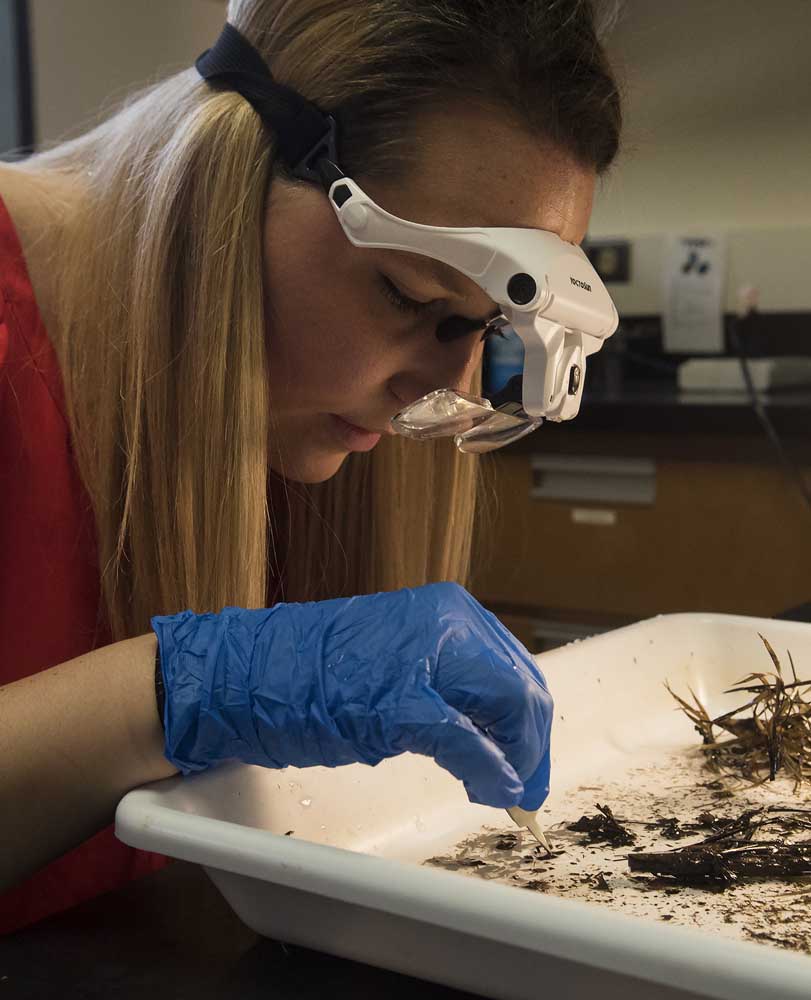UT Tyler professors team up with undergraduate students for summer research project
Published 2:15 pm Monday, July 23, 2018

- University of Texas at Tyler student Madison Currans separates invertebrates from debris as part of her research in using organisms as water quality indicators during the LSAMP summer research program at the University of Texas at Tyler on Thursday July 19, 2018. (Sarah A. Miller/Tyler Morning Telegraph)
The term “mutants” tends to conjure an image of mad scientists working toward some nefarious end, but at the University of Texas at Tyler, a research team is creating mutants to help better understand autism.
Dr. Brent Bill’s research involves altering the genetic code of zebra fish in order to figure out the function of the proteins tied to autism. The project is part of the University of Texas Louis Stokes Alliance for Minority Participation Summer Research Academy program, which teams UT professors with underrepresented minority students pursuing degrees in STEM (science, technology, engineering and math). Locally, students from UT Tyler and Tyler Junior College participate.
The program is designed to allow the undergrads an opportunity to perform research in order to encourage them to eventually pursue a graduate degree.
Bill is working with TJC student Aubry Dougherty on the zebra fish project, while Dr. Lance Williams is teamed with UT Tyler student Madison Currans to test the water quality of Army bases in Texas.
Over the past 26 years the LSAMP program has engaged more than 150 local students, with nearly a third completing their graduate degrees, program director Stephen Rainwater said.
In addition to the on-campus students, several students from last year’s cohort are participating in a Summer Research Academy abroad.
“The students are getting an opportunity to see what most undergrad students never see — the research,” Rainwater said.
Williams said the program gives him the opportunity to use a hands-on approach that he normally can’t do with a class full of students. With the research program, they can spend time at collection sites and be more intentional about what they’re gathering. Most of the bugs they are looking for are so small they can barely be seen with the naked eye.
Currans had previously taken an aquatic biology class with Williams, but said the research is helping her learn so much more than she could with just a textbook and lectures.
“Taking a class and actually doing it is a lot different,” she said. “Going in the field is the best. The first week I started, I would go home and close my eyes and see bugs.”
Throughout the past year a graduate student has been working on the chemicals needed for Bill’s research, which meant that he and Dougherty were able to jump right in to the genetic modification.
Preparing the solution, taking the sample and sending it off to be analyzed is about a day-long process, Dougherty said.
They extract the protein by clipping the tail of the fish, which grows back like a fingernail, Bill said. After they finish with all the samples, they’ll wait for the modified fish to mature and look at the differences between the sets with and without the proteins.
“I’m really lucky to have this experience,” Dougherty said. “It’s been really amazing. You get nowhere near this level of experience (in a class).”
Dougherty said she had originally planned to go into ecology, but has enjoyed the research so much she is reconsidering those plans.
“In a class you get to do one or two (fish), but this is her 40th or 50th,” Bill said. “Now we have to get them to breed and grow up. Hopefully we’ll have some mutations.”
Participating students receive a fellowship stipend because the research is so time intensive. At the end of the project, all of the UT campuses get together to present their findings.
Twitter: @TMT_Cory






